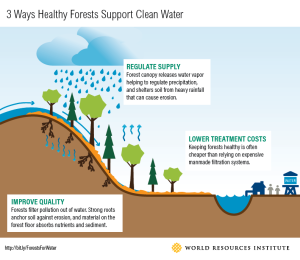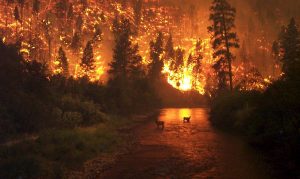8 Impacts of Wildfire on Water
Ziyun Tong
Wildfire impact on water supply
Whenever people talk about water, they always say water is the source of life. Undoubtedly, water is an important element for all living beings. But, besides from the rain, do you know that forests also provide a huge amount of water in the United States of America? According to the Forest Service, forests provide drinking water to more than 160 million people in the U.S. Also, millions of people depend on high-quality freshwater flowing from forests.
While it might amaze you, here are some breakdown of how forests have done so. The procedure all starts from the rain. As rain falls down to the Earth, the roots of trees help absorb excessive water. Then, the canopy of a forest then evaporates all the water absorbed from its roots. This not only prevents potential floods for the surrounding environment but also protects soil from heavy rainfalls that can potentially cause severe erosion. On top of these, the roots of forest can help firm up the soil and filter the water by absorbing sediment particles and nutrients. Besides its environmental benefits, protecting forests is also economically advantageous. Taking care of forests costs a lot less than building an artificial manual machine for supporting clean water. As a result, wildfire impacts on forests not only can directly damage the environment but also can negatively affect people’s access to clean water. Unfortunately, in the past few decades, due to climate change, global warming, and the increasing human population, the size of wildfire has skyrocketed, causing not only a decreasing clean water supply quantity but also a worsening quality.
Wildfires can exacerbate water quality issues both during active burning and even years after the fire has been extinguished. When wildfires occur in the forest, there will be countless black smoke and ash produced. These ashes and smoke are composed of chemical sediments such as heavy metals and organic compounds, which are both harmful to trees and human beings either from breathing in or indirectly absorbing it. As that smoke goes up, the temperature will decrease because of the increasing altitude. The smoke then condenses itself from gas to liquid and falls back down to the ground, the rivers, or the oceans. As a lot of these elements are water dissolvable, they will then be fixed into the water that people drink from daily life.
One of the most toxic compounds is Cyanide. It is one of the massive productions of wildfire. As it is soluble in water, there could be 30 µg/L (ppb) to 160 µg/L of cyanide in the water per wildfire, where as World Health Organization has stated: people should not even consume water with a cyanide concentration above 0.5 mg/L for more than 5 days.
Additionally, Wildfires release huge amounts of carbon through the mist. While the mist passes through the water, water would absorb some of the present gas. As this happens, numerous carbon dioxides would react with water forming what is called carbonic acid, from which hydrogen ions were dissociated, increasing the acidity of the water system. According to a recent study done by Dr. Alvarez-Bastida, total capture of carbon dioxide in drinking water not only represents a threat to human health, but also notes that water that has excessive acidity levels has been associated with erosion of teeth and bones, as well as digestive issues.
Furthermore, the temperature created by the wildfire can cause terrifying effects on a global scale. During the active burning of a wildfire, it will increase the temperature of forests’ surroundings and cause water in the river to evaporate, which can potentially result in lower water levels, leading several soils and ashes to merge into the water. Though it may not sound horrible scientifically, it is indeed horrifying to animals who have been living in the water for a long period of time. Their water structures might have been destroyed due to lower water level, not to mention all the toxic elements they would be breathing in under the water. Also, because finding a new home is always tough in the wild, most of the animals then will just end up dying from being forced away from their home land. Sadly, it is not even the worst part yet. As the time goes by, the corpses of these dead animals will further pollute the drinking water through gradual dissolution. If people drink water that roots from those contaminated areas, they might get botulism which could lead to serious symptoms such as slurred speech and difficulty breathing.
On the other hand, the elimination of the trees in the forest caused by wildfire can also affect water quality from the destruction of roots. As mentioned earlier, roots of the trees strengthen the integrity of the soil. If the fire burns down the trees, it will also burn their roots and thus abolish the functionality of the roots. Soil will then be affected by erosion and lead to massive amounts merging into the river.
However, the quantity of water flow will increase as the amount of wildfire increases. The recent research done by Dr. Hallama has shown that wildfires actually tend to increase river flows. By studying areas such as California, mid-Atlantic, and lower Mississippi, where wildfire occurs relatively more frequently, Dr. Hellama and his team have concluded the positive correlation with wildfires and their regional river flow. Furthermore, to minimize the bias involved in this research such as severe weather events, Dr. Hellama has subtracted the local climate-based flow prediction for each fire. The higher river flow creates more carrying of sediments down the lower stream where most sources of water are collected.
In conclusion, wildfire has not only impacted the air quality but also the water supply. Moreover, it does so through various steps that eventually form an unstoppable cycle where a snowball effect could take in. Thus, one of the best solutions for encountering these problems is through prevention. With global warming taking part as contributors, it is everyone’s responsibility to protect the environment that we all live in. However, understanding that most wildfires are caused by lightning, which is something difficult to control, we could also minimize the consequences done by wildfires through management.
Work Cited
Alvarez-Bastida, C., et al. “Estimation and Impact of Carbon Dioxide Capture on Drinking Water: Tillmans Equilibrium Diagram.” Journal of Water and Climate Change, vol. 11, no. 2, 2019, pp. 380–389., https://doi.org/10.2166/wcc.2019.038.
Bladon, Kevin D., et al. “Wildfire and the Future of Water Supply.” Environmental Science & Technology, vol. 48, no. 16, 2014, pp. 8936–8943., https://doi.org/10.1021/es500130g.
California Water Science Center, U.S. Geological Survey. “Water Quality after a Wildfire.” Water Quality & Wildfire | USGS California Water Science Center, https://ca.water.usgs.gov/wildfires/wildfires-water-quality.html.
Forster, Liz. “From Root to Tap: How Trees Ensure Fresh Water Supply.” National Forest Foundation, 15 Oct. 2021, https://www.nationalforests.org/blog/earth-month-watersheds#:~:text=Forest%20lands%20furnish%20more%20than,Portland%2C%20Denver%2C%20and%20Atlanta.
Hallema, Dennis W., et al. “Burned Forests Impact Water Supplies.” Nature Communications, vol. 9, no. 1, 2018, https://doi.org/10.1038/s41467-018-03735-6.
Lyons, Katie, and Todd Gartner. “3 Surprising Ways Water Depends on Healthy Forests.” World Resources Institute, 21 Mar. 2017, https://www.wri.org/insights/3-surprising-ways-water-depends-healthy-forests#:~:text=Forests%20help%20control%20the%20water,down%20the%20flow%20of%20runoff.
U.S. DEPARTMENT OF AGRICULTURE. “Water Facts.” US Forest Service, https://www.fs.usda.gov/managing-land/national-forests-grasslands/water-facts.
United States Environmental Protection Agency. “Climate Change Indicators: Wildfires.” Environmental Protection Agency, July 2022, https://www.epa.gov/climate-indicators/climate-change-indicators-wildfires.



